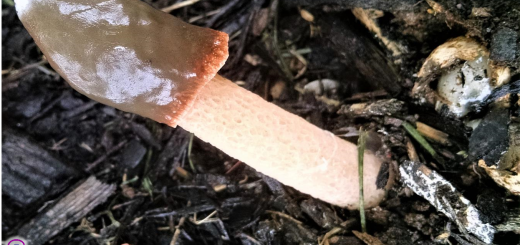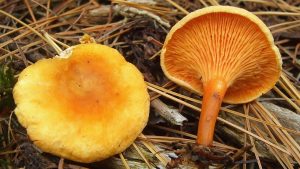#005: Xylaria polymorpha, Dead Man’s Fingers [Archived]
Note: this is an archived post. You can read the updated version here.
October is Creepy Fungus Month on Fungus Fact Friday! To start this month I have chosen to highlight Xylaria polymorpha–Dead Man’s Fingers. When you look at this fungus’ fruiting bodies in the summer or fall it is easy to see how it got its common name. The mushrooms are more or less straight, though often bent or warped. Their exterior is black, wrinkled, and bumpy and becomes cracked with age. The individual mushrooms often grow close together and may become fused at the bottom, forming a “hand” with several “fingers.” X. polymorpha is a wood decomposer, but can often appear to grow from the ground when decomposing buried wood. Thus, this mushroom often resembles a burnt, dead hand reaching out of the ground to grab unwitting passers-by and drag them down into the depths of the earth. Fortunately for you, X. polymorpha does not have a taste for human flesh. As I mentioned before, it is a wood decomposer. Like many of its fellow wood-rotting ascomycetes, it is a soft rotter. If you want more proof that these are not discarded human fingers, cut one open. You will probably be surprised to find that they are white on the inside and have small, black dots around the edges. These dots (called perithecia) are where spore production happens. Each perithecium is lined with spore-producing cells called asci. These asci slowly elongate, growing toward a small hole (called an ostiole) in the perithecium which connects to the air outside. Once the asci reach the ostiole, they shoot their spores out into the air. This process is very slow compared to most mushrooms, which quickly release all of their spores over the course of a few hours or days and then stop. X. polymorpha releases its spores slowly. The fruiting bodies first appear in spring or summer and produce spores through winter. Some can even continue producing spores for a year or more. When the fruiting bodies first appear in the spring, they are almost unrecognizable as X. polymorpha. They are a light blue color with white tips and are short and round rather than finger-like. During this stage, X. polymorpha produces asexual spores, which accumulate as a white film over the mushroom. Because of this white film, this phase is called the “candlesnuff” phase. By the time they look like dead fingers they switch to producing sexual spores.








![#011: Characteristics of Kingdom Fungi [Archived]](https://www.fungusfactfriday.com/wp-content/themes/hueman/assets/front/img/thumb-small-empty.png)



2 Responses
[…] the fruiting body. However, in some earth tongues look-alikes, like the Dead Man’s Fingers (Xylaria polymorpha), the stipe is not very well defined. That being the case, the earth tongue look-alikes are often […]
[…] host of species that are similar to T. ophioglossoides. Black earth tongues, Dead Man’s Fingers (FFF#005), and species from Cordyceps and Ophiocordyceps can all easily pass for T. ophioglossoides, […]